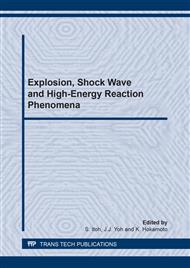p.203
p.209
p.215
p.219
p.225
p.231
p.237
p.243
p.247
Behavior of Bubble in Small Water Tank Used for Food Processing Using Underwater Shock Wave
Abstract:
The food processing technology using a shock wave can prevent deterioration of the food by heat because it can process food in a short time. Generally, since the shock wave used for food processing is generated by underwater explosion, the load of a shock wave to the food becomes very complicated. Therefore, in order to process safely, it is important to clarify the behaviors of the shock wave and the bubble pulse generated by underwater explosion. In this research, in order to investigate the behavior of the shock wave in the water tank used for food processing, the optical observation experiment and the numerical simulation were performed. In the experiment, the shock wave generated by underwater explosion was observed with the high-speed video camera. The numerical simulation about the behavior of bubble pulse was performed using analysis software LS-DYNA. Comparing and examining were performed about the experimental result and the numerical simulation result. The result of the numerical simulation about the behavior of the shock wave generated by underwater explosion and the shock wave generated by the bubble pulse and the bubble pulse was well in agreement with the experimental result.
Info:
Periodical:
Pages:
225-230
Citation:
Online since:
January 2011
Authors:
Keywords:
Price:
Сopyright:
© 2011 Trans Tech Publications Ltd. All Rights Reserved
Share:
Citation:


